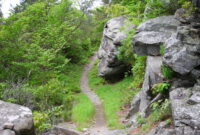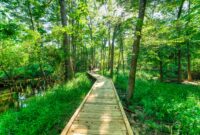Popular hiking trails near me offer a fantastic escape into nature, providing opportunities for exercise, exploration, and relaxation. This guide delves into finding, understanding, and enjoying the best nearby trails, equipping you with the resources and knowledge for safe and rewarding adventures. We’ll cover everything from discovering local trails using various online resources to understanding trail difficulty, essential gear, and safety precautions.
From discovering hidden gems to navigating well-known paths, we’ll explore the process of finding the perfect hiking trail to match your skill level and preferences. We’ll also discuss the importance of responsible hiking practices and environmental stewardship, ensuring these trails remain enjoyable for all.
Trail Data Organization & Presentation
Effective organization and presentation of trail data are crucial for creating a user-friendly and informative hiking resource. A well-structured database allows for easy comparison of trails, enabling users to quickly find options that match their preferences and abilities. This section details a method for organizing trail data and presenting it in a visually appealing and functional HTML table.
Organizing trail data into a structured format involves identifying key attributes relevant to hikers. This typically includes the trail name, difficulty level, length, and a concise description. This structured approach facilitates efficient data management and enables powerful search and filtering capabilities.
Trail Data in HTML Table Format
The following HTML table presents sample trail data, organized for easy comparison. The table uses four responsive columns for optimal viewing across various devices. Each row represents a different trail, with its name, difficulty, length, and a brief description. This format allows users to quickly scan and compare trails based on their individual needs and preferences.
| Trail Name | Difficulty | Length (miles) | Description |
|---|---|---|---|
| Eagle Peak Trail | Strenuous | 8.5 | Challenging climb with stunning panoramic views. Requires good fitness level. |
| River Valley Trail | Moderate | 4.2 | Gentle, scenic trail along a river. Suitable for families. |
| Forest Canopy Trail | Easy | 2.1 | Flat, shaded trail ideal for a leisurely walk. Minimal elevation change. |
| Summit Ridge Trail | Difficult | 6.0 | Steep inclines and rocky terrain. Experienced hikers recommended. |
Visually Appealing Presentation of Trail Information
To enhance the visual appeal and user experience, consider incorporating design elements such as color-coding for difficulty levels (e.g., green for easy, yellow for moderate, orange for difficult, red for strenuous), using clear and concise fonts, and adding high-quality images or maps of each trail. The use of responsive design ensures the table adapts seamlessly to different screen sizes, maintaining readability and usability across all devices.
Filtering and Sorting Trails
Implementing filtering and sorting capabilities significantly enhances the user experience. This allows users to refine their search based on specific criteria such as difficulty level, trail length, or keywords in the description. This could be achieved using JavaScript to dynamically update the table based on user selections from dropdown menus or input fields. For instance, a user could select “Moderate” difficulty and “3-5 miles” length to display only trails matching those criteria. This interactive approach empowers users to efficiently find trails that meet their individual preferences.
Visual Representation of Trails
A compelling visual representation of a hiking trail is crucial for attracting potential hikers and providing them with a realistic expectation of the experience. Effective visuals combine descriptive text with evocative imagery, painting a picture in the reader’s mind of the journey ahead. This includes showcasing the trail’s unique features, the challenges involved, and the rewards awaiting those who undertake the trek.
The visual elements of a popular hiking trail are diverse and contribute to its overall appeal. Imagine, for instance, the breathtaking panoramic views from a mountain summit, where layers of rolling hills meet a vast, clear sky. The vibrant greens and yellows of a lush forest canopy might contrast sharply with the rugged texture of a rocky terrain, where exposed rock formations create interesting obstacles and photographic opportunities. A cascading waterfall might add a touch of dynamism to the scene, while a serene mountain lake offers a tranquil moment for reflection. These elements, carefully described, create a vivid mental image for the reader.
Trail Elevation Profile Description
The trail’s elevation profile can be effectively conveyed through a textual description that avoids technical jargon. For example, one could describe a trail as starting with a gentle incline through a shaded forest, gradually increasing in steepness until reaching a challenging climb over rocky terrain. This section might be described as a sustained, strenuous ascent of approximately 500 feet over one mile, before reaching a plateau offering stunning views. The descent might then be characterized as a series of switchbacks, winding gradually downward through open meadows, eventually leading to a more gradual decline to the trailhead. This detailed description provides hikers with a clear understanding of the physical demands of the trail.
Conveying Trail Atmosphere and Experience
Descriptive language is essential for conveying the atmosphere and experience of a trail. Instead of simply stating that a trail is “difficult,” one could describe the feeling of exertion as hikers navigate steep, rocky inclines, the exhilaration of reaching a panoramic viewpoint, the sense of peace and tranquility in a quiet forest, or the refreshing coolness of a shaded path on a hot day. The scent of pine needles, the sound of rushing water, the feel of cool air on the skin – these sensory details immerse the reader in the experience, making the trail more appealing and accessible. For instance, describing the trail as “a journey through a cathedral of towering redwoods, their ancient branches filtering sunlight into a mystical green twilight,” evokes a very different feeling than describing it as “a steep, rocky path through a dense forest.” The choice of words dramatically impacts the reader’s perception of the trail.
Closure
Exploring the popular hiking trails near you is an enriching experience, blending physical activity with the beauty of the natural world. By using the resources and tips provided, you can confidently plan and enjoy safe and memorable hikes, connecting with nature and discovering new perspectives. Remember to always prioritize safety, respect the environment, and leave no trace behind.




